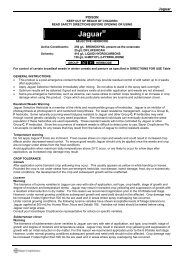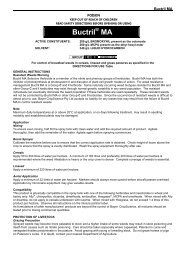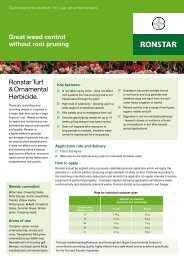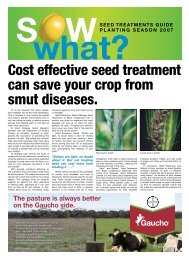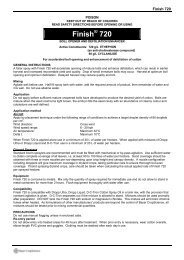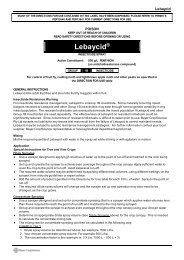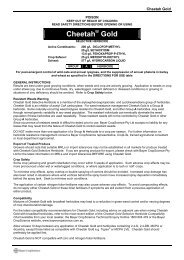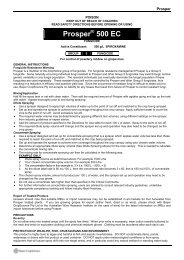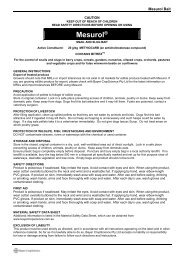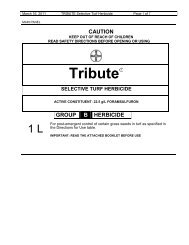TOxICOLOGICAL PROPeRTIeS - Bayer CropScience
TOxICOLOGICAL PROPeRTIeS - Bayer CropScience
TOxICOLOGICAL PROPeRTIeS - Bayer CropScience
Create successful ePaper yourself
Turn your PDF publications into a flip-book with our unique Google optimized e-Paper software.
Foliar fertilisers<br />
Glasshouse pot trials in Western Australia by Robson<br />
and Snowball (1989) demonstrated soil-incorporated<br />
diclofop-methyl (a key component of Cheetah Gold)<br />
could induce zinc deficiency in wheat.<br />
Graph 9. Wild oat control with Cheetah Gold plus foliar zinc fertiliser<br />
% wild oat control<br />
100<br />
95<br />
90<br />
85<br />
80<br />
75<br />
70<br />
Cheetah Gold<br />
1 L/ha + Uptake 0.5% v/v<br />
Trial ID: 05ND11, 05ND12, 05VA16, 05VA17, 05VB07, 05SA15<br />
Cheetah Gold 1 L/ha<br />
+ Uptake 0.5% v/v<br />
+ Twin Zinc 350 mL/ha<br />
Trials indicate that the addition of zinc oxide to Cheetah<br />
Gold has a negative impact on wildoat control, as shown<br />
by the graph below.<br />
No information is available on mixtures with other foliar<br />
fertilisers, and therefore cannot be recommended.<br />
Cheetah Gold 1 L/ha<br />
+ Hasten 1% v/v<br />
Cheetah Gold 1 L/ha<br />
+ Hasten 1% v/v<br />
+ Twin Zinc 350 mL/ha<br />
Annual ryegrass control is affected less than wild oats if foliar zinc is added to Cheetah Gold.<br />
Graph 10. Annual ryegrass control with Cheetah Gold plus foliar zinc fertiliser<br />
% annual ryegrass control<br />
100<br />
95<br />
90<br />
85<br />
80<br />
75<br />
70<br />
Cheetah Gold<br />
1 L/ha + Uptake 0.5% v/v<br />
Trial ID: 05NW16, 05NW17, 05VA16, 05VA17<br />
NB. VA16 and VA17 low levels of Group A resistance developing.<br />
Cheetah Gold 1 L/ha<br />
+ Uptake 0.5% v/v<br />
+ Twin Zinc 350 mL/ha<br />
Cheetah Gold 1 L/ha<br />
+ Hasten 1% v/v<br />
Cheetah Gold 1 L/ha<br />
+ Hasten 1% v/v<br />
+ Twin Zinc 350 mL/ha<br />
Highest<br />
result<br />
Average<br />
result<br />
Lowest<br />
result<br />
Highest<br />
result<br />
Average<br />
result<br />
Lowest<br />
result<br />
CROP SAFETY<br />
Crop discolouration and biomass reductions<br />
Cheetah Gold can cause crop discolouration shortly<br />
after application. The typical symptoms include<br />
yellowing of the plant material. Diclofop-methyl<br />
penetrates the cuticle and epidermis rapidly, but<br />
translocation in the phloem is relatively slow. Movement<br />
in the xylem is more rapid, leading to an accumulation<br />
of active ingredient at the leaf tips. This can result in<br />
burning of the wheat and barley leaf tips. Transient<br />
Graph 11. Maximum crop discolouration in wheat trials – Cheetah Gold 1 L/ha<br />
% maximum crop discolouration<br />
in wheat trials<br />
% maximum crop discolouration<br />
in barley trials<br />
30<br />
25<br />
20<br />
15<br />
10<br />
5<br />
0<br />
30<br />
25<br />
20<br />
15<br />
10<br />
5<br />
0<br />
06ND08<br />
06ND06<br />
05WA16<br />
06ND10<br />
05ND12<br />
06ND19<br />
06ND09<br />
05ND09<br />
06NW13<br />
06ND17<br />
05ND11<br />
05SA12<br />
05WA15<br />
05VB07<br />
06NW17<br />
04WB13<br />
04ND01<br />
06SA55<br />
05VA16<br />
05WA12<br />
04ND23<br />
06WB08<br />
06NW14<br />
06ND11<br />
05NW15<br />
05SA15<br />
05NW16<br />
05WB07<br />
05WB06<br />
04SA44<br />
04SA43<br />
05WA14<br />
04WA10<br />
04VB12<br />
06ND18<br />
04VB09<br />
06NW15<br />
06ND07<br />
04VB11<br />
05NW17<br />
05WA17<br />
05WB05<br />
06NW11<br />
06VB06<br />
Adjuvant Hasten 1% v/v or Uptake 0.5% v/v<br />
04QG10<br />
04QG08<br />
05ND08<br />
05ND10<br />
05SA14<br />
05SA11<br />
ND32/05<br />
04WA11<br />
05WB17<br />
05WB27<br />
06ND20<br />
06NW08<br />
04SA44<br />
Trial ID<br />
Graph 12. Maximum crop discolouration in barley trials – Cheetah Gold 1 L/ha<br />
04ND23<br />
06WA14<br />
06SA55<br />
whitening at the base of new leaf emergence may occur,<br />
affecting new growth.<br />
Under cold, wet, waterlogged conditions or nutrient<br />
stress, these crop effects can be severe. Older leaves<br />
turn yellow and there is significant necrosis. New<br />
growth is unaffected and the crop recovers in<br />
about 4 weeks. In some cases new growth may show<br />
transient whitening and growth may be slowed. The<br />
maximum effect is 21–28 days after application, with<br />
recovery being 40–60 days after application. Where<br />
plants have been double-sprayed through overlap,<br />
effects may remain noticeable up to harvest.<br />
SA42/05<br />
04VB09<br />
05VA14<br />
05VA15<br />
05VB06<br />
05VA17<br />
05NW15<br />
05WB28<br />
ND31/05<br />
04ND21<br />
06WA15<br />
06QC08<br />
Adjuvant Hasten 1% v/v or Uptake 0.5% v/v<br />
Trial ID<br />
12 13



